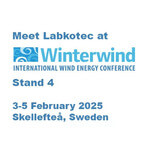News Release from Fraunhofer-Institut für Windenergiesysteme IWES
Wind Industry Profile of
Ground Broken on New Test Stand for Generator/Converter Systems
If all goes to plan, a new test stand for minimal systems – comprising a high-speed generator and converter system – is set to open there in spring 2019. This test facility is being financed in the scope of the HilGridCop project funded by the German Federal Ministry for Economics Affairs and Energy (BMWi). The aim of its use is accelerated electrical certification testing of wind energy turbines at considerably lower costs than those associated with the testing of a complete nacelle. The new test stand and the DyNaLab will share a virtual grid, which will be expanded substantially so as to allow additional and more advanced functions.
Construction projects so close to the port quay in Bremerhaven bring with them special requirements: in order to be able to lay resilient heavy-duty foundations with a 15 cm-thick steel plate in the sandy ground, there are 30 piles measuring 15 meters in length in place to secure the foundation plate. This results in a load-bearing capacity of 650 tonnes. The costs for the new building will be shared between Fraunhofer IWES and the parent company.
The funding for the test structure for power engineering components that will be housed within it will come from the “HilGridCop” project. The testing of minimal systems for certification of the electrical system on its own requires high speeds and a low torque. The test structure will be equipped with a 9 MW drive unit (max. 13 MW in overload) for the reproduction of realistic generator moments using the hardware-in-the-loop (HiL) method. The use of detailed real-time models will ensure optimal exchange of data with the test stand control.
In parallel to the construction of the building, a testing method is also being developed. Its objective is to perform electrical certifications of systems up to 6-7 MW with two- to three-stage gearboxes completely in the laboratory at minimal costs. This offers system manufacturers the advantage of lower time and financial requirements in comparison with tests on the nacelle test stand thanks to the partial automation of processes and simplified logistics:
“For software-supported test management, we are integrating approaches from the automobile industry with the aim, for example, of establishing standardized interfaces to the customer, generating test profiles from the test specification, and only having to control part of the test process manually,” explained Dipl.-Ing. Torben Jersch, Head of Department, Division Turbine and System Technology.
In addition, there are already plans for considerable expansion of the functionalities of the existing virtual grid that will be shared by DyNaLab and the new test stand in order to satisfy the grid integration requirements of future wind turbines: the aim is to be able to replicate systems from extremely weak grids up to special harmonic interference spectra.
The first users of the HilGridCop test stand are already waiting in line: the project partners Senvion, Nordex, and Vestas will be the first to test out their minimal systems using the new test structure in 2019. In order to compare and evaluate the results from the laboratory tests, they will also be providing operating data obtained in the field. Each partner is then supplied with only his results for validation purposes.
Testing of grid compatibility for certification of the electrical characteristics of new wind energy turbines (or for recertification of existing models in case of modifications and further developments) is currently almost exclusively performed in situ in the field. The certification campaign generally lasts up to two years in order to test the turbine’s capacity in all weather conditions and grid situations. As such, the industry’s interest in concluding the certification by a defined date and shortening development times whilst obtaining reproducible results all the while is correspondingly high and consistent.
- Source:
- Fraunhofer IWES
- Author:
- Press Office
- Link:
- www.iwes.fraunhofer.de/...
- Keywords:
- Fraunhofer IWES, wind energy, test stand, nacelle, generator, converter, wind turbine

























